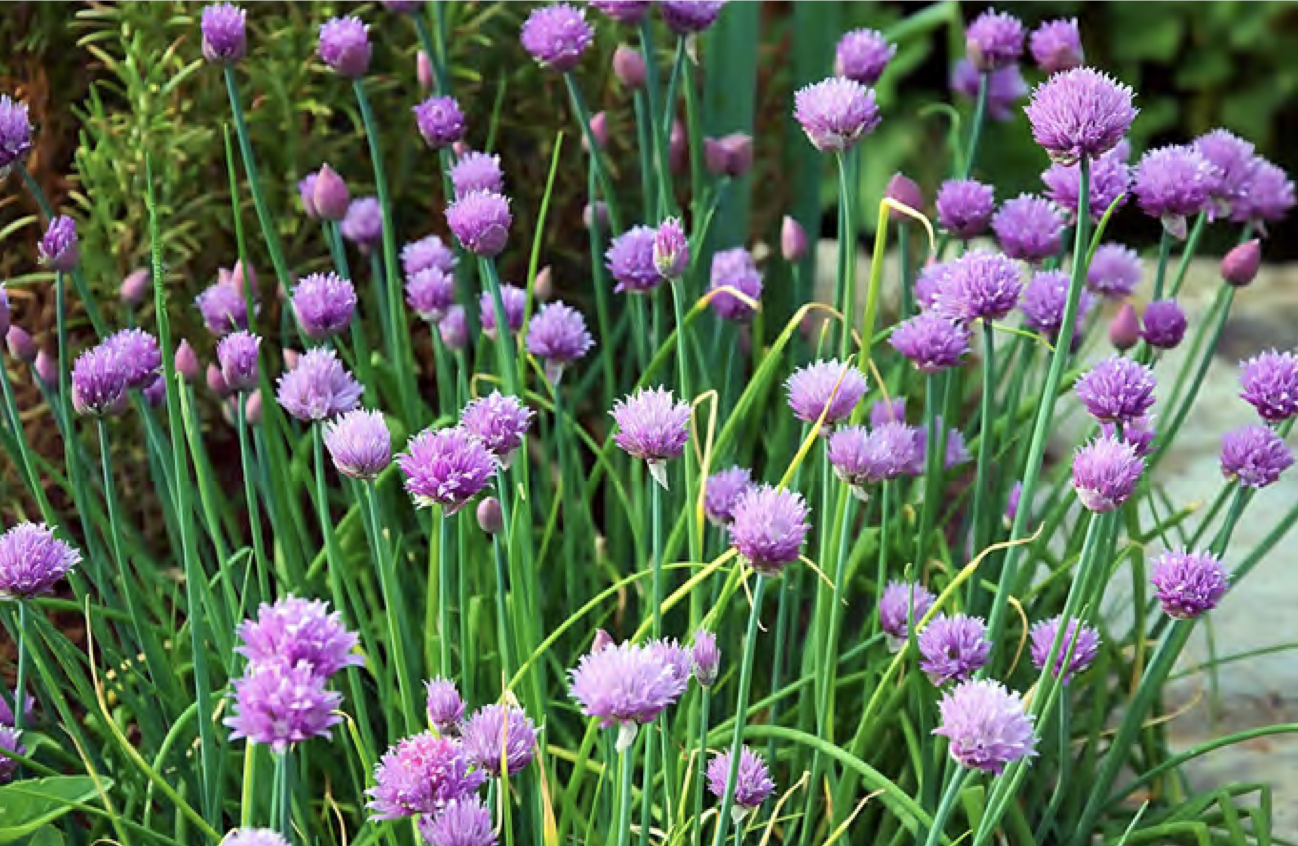
Herb of the Month: Siberian Chives
by Karen McGowan, Master Gardener
In the event that you are like most of us, and don’t study chives for a living nor for a hobby, you may not be aware that there are several varieties of them. Although I would definitely categorize myself as a chives fan and of alliums, in general, it had simply never occurred to me until researching for this month’s article that there are several varieties of chives, just as there are of onion and garlic – a couple more notables in the allium family.
This month we are focusing on Siberian chives, of which there exists also a giant variety (Allium ledebourianum). Since, by most accounts, giant Siberian chives don’t do quite as well in our grow- ing zone, we will focus on Siberian chives (Allium nutans). Many may be aware of the handy gardening trick of pairing chives with roses to help ward off unfriendly insects, and that is definitely a key usage of this versatile, attractive herb. A perennial such as Siberian chives that is both deer resistant and an inherent pest shield is a welcome addition to any garden; the beautiful blue to light purple orbs that dance at the end of relatively sturdy stems averaging between twelve and twenty-four inches makes Siberian chives a popular option for garden borders, particularly those housing roses. The greyish-green stems of this variety together with the herb’s flowering colors create a fetching foil within most garden styles, ranging from clean and modern to shabby-chic cottage. Enduring, spherical bloom bobs topping Siberian chives’ stems establish great garden architecture. An herb that can accomplish all of these things in south Texas’ rugged conditions is one to savor.
Speaking of savory (see what I did there?), Siberian chives aren’t all looks; this is an herb for cooks! Common culinary uses include risotto, omelet, garnishes, salads, along with cheese and vegetable dishes. And of course, baked potatoes...I don’t know about you, but I for one look askance at any steak restaurant that doesn’t offer chives on baked potatoes (or doesn’t stock A1 steak sauce, but that’s a different article). Chopped chives are a winning add to the flavor profiles of all of these dishes, and more.
If you happen to be a beginning gardener in need of a confidence-builder, meet Siberian chives, your new best friend. Plant this hardy perennial in the ground for best results, 12-18 inches apart in well-drained soil, anywhere from full sun to partial shade (the latter will cause the herb to produce less showy flowers).
As most chive varieties do, Siberian chives tends to spread like a groundcover, so be prepared to train it back when necessary, should a ground cover not be desired. Deadheading the flowers immediately after they’re spent ought to preempt an aggressive spread. Again, chives make an excellent barrier to keep unwanted pests out of your garden, as they simply don’t appreciate the strongly scented herb. Siberian chives also attract pollinators and butterflies, even as they ward off unwelcome garden visitors.
Growing Siberian chives from seeds is pretty much a cinch: Chive seeds sown outdoors in the spring usually germinate within a few weeks. Ideally, temperatures will need to be between 65° and 75° Fahrenheit. Ensure that seeds are sown near to the surface and that they aren’t spaced too closely together. Whenever germinating these seedlings indoors to transplant outdoors, harden them off first with increasingly long visits outdoors over a period of around 10 days. Chives are likewise easily propagated by division and, in addition to deadheading flowers, dividing every few years will prevent garden crowding.
Harvesting is just as easy! According to the experts at The Spruce, “chives are usually ready to harvest within a couple of months of seed germination, or about 30 days after nursery seedlings are planted. It's a good idea for aesthetics, and to encourage healthy regrowth, to cut the leaves right down to the base. You can harvest at any time, but be aware that old growth can be tougher and not quite as flavorful. New plants should be harvested four or five times in their first year. Mature plants should be harvested monthly.” Since chives don’t dry well – losing their flavor completely – consume immediately upon harvesting. And don’t forget the flowers - these are consumable, as well; pick immediately after they have fully opened, as this is when they offer the very best taste.
If you’re looking for the immediate impact of a mature Siberian chives plant, south Texas garden centers, even in November, are usually accommodating. If not, put this flexible garden charmer on your spring planting list, and enjoy its diverse benefits for years to come! Happy Thanksgiving to all!
Source: Harris County Master Gardeners Urban Dirt Newsletter (November 2022 Edition)
About Urban Dirt
Each month, Harris County Master Gardeners publishes an informative, resourceful newsletter entitled "Urban Dirt". This article was derived from the November 2022 edition. To read the November 2022 edition of this newsletter, click the button below.







